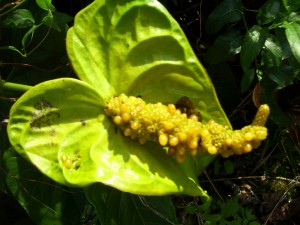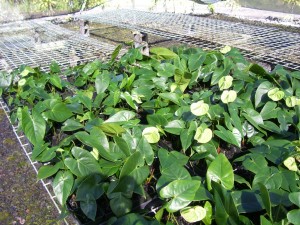Anthurium Propagation: Seeds, Cuttings & Tissue Culture
There are three ways to propagate anthurium plants: you can take cuttings; you can grow them from seeds; or you can tissue culture them. Cuttings are easy for anyone to do. Seeds are a little more difficult to do, and tissue culture is generally reserved for scientists in labs or really advanced anthurium cultivators.
Anthurium Cuttings
Cuttings are by far the easiest way to propagate your anthurium plant. The best part about taking cuttings is that the plants you produce will look exactly the same as the parent plant. First, you must wait until your plant is big enough to allow a cutting to be taken. Generally you’ll want to see at least four nodes, or sets of leaves and roots, before taking a cutting. Once your plant is big enough, cut it in half, so that each portion has at least two nodes. Leave the base of your plant in its original pot and it will generate new growth. Then put the top cutting into a new pot, water it regularly and it will keep growing, too.
Anthurium Seeds
Anthurium seeds are another way to propagate your plant. However it is a much more difficult process and takes a lot more patience. The stigma and stamen of these flowers are active at different times, so if you want to produce seeds you will have to store pollen in the freezer or have two flowers at different stages of development. So the first thing you have to do is gather pollen. Use a paint brush to scrape pollen off the stamen and into a vial. Keep this vial in the freezer until you see that the stigmas are ready to be pollinated. Once you have a flower with receptive stigmas dust a little pollen over it. Next you will have to wait for approximately a year for seeds to be produced.
Anthurium Tissue Culture
Tissue culture is almost exclusive done within the confines of a lab, with the exception of really high end hobbyists and growers. It is best left to commercial growers because it is very expensive and is generally used when one wants to produce thousands of genetically identical plants. So how does an anthurium farmer tissue culture an anthurium plant?
First, the anthurium farmer chooses an ideal specimen. This specimen will be replicated thousands of times, so a lot of time and effort is put into choosing the very best specimen available. Once this precious plant is selected, the farmer takes it to a lab.
In the lab, a scientist confirms that the specimen is healthy and then chops off a piece of it. Then the scientist will sterilize the sample and put it into a beaker that contains an agar based gel. This beaker also contains special plant hormones that trigger the sample to form a callus, which is an undifferentiated mass of plant cells.
The callus is divided into many portions and then allowed to grow once more. This method is replicated multiple times. Once sufficient material is created, the calluses are moved to a growing media which contains plant hormones that cause the undifferentiated cells to transform into roots and shoots. This causes hundreds of plantlets to sprout from every callus.
After the plantlets have grown sufficiently, they’re transplanted into brand new flasks to mature further. Once they have reached a size where they can survive in open air, they are removed from the beakers and transferred into pots. These new plants are allowed to mature in the tightly controlled conditions of a plant nursery for a while. Then, after they have adjusted to growing in open air, they’re returned to the farmer for transplanting into his fields.
Anthurium Plants: How to Keep Them Alive
Anthurium plants are vulnerable to a number of diseases, pests and poor care practices, but overall they are really easy plants to care for. In this article I am going to give you guidelines that will help you to keep your anthurium plant in excellent shape. And of course I am also going to tell you the quickest way to kill an anthurium. This one common mistake is responsible for killing more anthurium plants than all of the other mistakes combined.
The Two Keys Of Anthurium Plant Care
The two most important components of anthurium care is choosing a good location to keep your plant and watering it properly. When it comes to location, temperature, light levels and humidity are all very important aspects. With watering, both too much and too little water can cause major problems. Everything else, including fertilizing, pruning, re-potting and even pest management is secondary. To learn more about these two critical items, please review my article on anthurium care.
Light Levels: A Commonly Overlooked Factor
Light levels are critical to anthurium plants. Too much light and your plants will burn. Too little light and your plants will be stunted. The key is to strike a good balance between these two extremes. In general, you should never put your anthurium in a location that receives strong, direct sunlight. The anthurium is a rain forest dwelling plant and requires weaker, filtered sunlight. You can accomplish this by keeping your plant near a window, but out of direct sunlight or you can put a thin, gauzy curtain over your window to block out a portion of the sun’s rays.
Anthurium Pests And Diseases
When it comes to pests and diseases, you will be pleased to know that if you are only raising a few indoor plants, the majority of the pests and diseases that plague anthurium plants that are grown in a commercial setting will be of no major consequence to you. Thrips, mites, nematodes, white flies and even the deadly Xanthomonas blight should be of little concern to you.
The main disease that you have to watch out for is root rot. This is caused by a fungus that thrives in moist, warm environments. Fortunately, it is easy to prevent this disease. All you have to do is pay attention to how you water your plant. Always make sure that all excess water is allowed to drain away from the roots of your plant and make sure that you wait for the roots to dry slightly before watering again. Assuming you are using a porous potting soil, you can water daily and still meet these two conditions. You can find more detailed information in my article on anthurium pests.
The Biggest Mistake
And finally the biggest mistake you can make with an anthurium plant is very simple and easy to do. I wish that this wasn’t the case, but this one mistake is responsible for killing more anthurium plants than all the other causes combined. And it is forgetting to water your anthurium plant. In the rain forest, these plants receive water on a daily basis. Obviously rain doesn’t fall in your home, so it is up to you to water them. I believe that the best way to remember to water them is to keep them in a location where you see them everyday and just make it a habit to water them everyday at the same time of the day. And remember, if you are watering them on a daily schedule; make sure you have them planted in a potting mix that drains well to avoid root rot.
Anthurium Plant Video
This is a brief video on how to care for a potted anthurium plants. It covers potting, watering and sunlight requirements.



